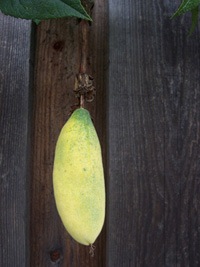 The folks over at The Human Flower Project are trying to identify this fruit, which apparently can be found in abundance in Oakland, California. They think they’ve pinned it down to Passiflora mollissima, but maybe you know better. I grew P. mollissima once, in an unheated greenhouse, and although it flowered well enough it didn’t set fruit. So although the flowers look familiar, the fruit remains a mystery. One of the reasons I wanted to grow it was to do this:
The folks over at The Human Flower Project are trying to identify this fruit, which apparently can be found in abundance in Oakland, California. They think they’ve pinned it down to Passiflora mollissima, but maybe you know better. I grew P. mollissima once, in an unheated greenhouse, and although it flowered well enough it didn’t set fruit. So although the flowers look familiar, the fruit remains a mystery. One of the reasons I wanted to grow it was to do this:
“The pulp is eaten out-of-hand or is strained for its juice, which is not consumed alone but employed in refreshing mixed cold beverages. In Bolivia, the juice, combined with aguardiente and sugar, is served as a pre-dinner cocktail. Colombians strain out the seeds and serve the pulp with milk and sugar, or use it in gelatin desserts. In Ecuador, the pulp is made into ice cream.â€
Those treats remain a fond hope. I had a quick look to see whether the juice or pulp might be available commercially in Europe, but couldn’t find anything. Is it?
Hi Jeremy,
While rather similar to Passiflora mollissima (now classified as Passiflora tripartita var. mollissima), the fruit in the picture actually is Passiflora tarminiana, a species that was only described in 2001 (by Geo Coppens d’Eeckenbrugge, who was working in Bioversity’s office for the Americas at that time).
Being a very commonly grown and marketed fruit in Ecuador and Colombia (excellent juices indeed! look for curuba juice), and considered an invasive weed in the US (Hawaii), it is amazing that it took so long for this species to be properly described. It had always been (and still is) confused with Passiflora tripartita var. mollissima, although it is slightly different morphologically (the fruit is more fusiform).
This confusion has given us a lot of headaches when carrying out spatial studies on passion fruit diversity based on herbarium specimens (all samples collected before 2001 still use the mollissima classification).
Surprisingly, local “banana passion fruit” growers in Colombia do separate both species easily.
There is some good information on this species in Wikipedia (http://en.wikipedia.org/wiki/Passiflora_tarminiana). Unfortunately, the link to the 2001 paper is broken.
I hope this helps.
Dear Jeremy and Xavier,
Thank you so much for sending this query around and supplying such a thoroughgoing and interesting (and for Georgia’s purposes, encouraging, answer).
It would be interesting to learn how this plant got a fence-hold in Oakland and Berkeley.
Good wishes,
Julie